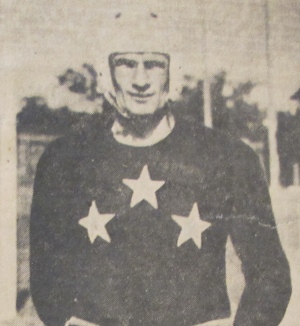Few Canadians realize it, but the small southwestern Ontario city of Sarnia was once a football powerhouse, hosting the Grey Cup game once and winning the trophy twice.
“Outside of these parts, not a lot of people know what happened back in the day,” says Jeff Perry. “We are kind of the hidden secret here in Sarnia.”
It’s not a secret to Perry because his grandfather was Norm Perry, nicknamed The Galloping Ghost for his blazing speed on the football field.
Sarnia Imperials legend Norm Perry was nicknamed The Galloping Ghost for his speed on the football field. (Sarnia Lambton Sports Hall of Fame)
The 1933 Grey Cup game was played in Sarnia, the home team losing to the Toronto Argonauts in a close contest that, Sarnia legend has it, was decided by a botched call.
“My grandfather was gone on a touchdown and got called back,” says Perry ruefully. “It came pretty close to causing a riot back in the day.”
Sarnia went on to win the next year and won the Grey Cup again in 1936. It was an era before the CFL was formed, when the game looked a lot more like rugby than football as it is played today.
“We were Grey Cup champions,” says Jan Allardyce at the Sarnia Lambton Sports Hall of Fame. “The almost unknown Imperials.”
Industry gave players job security
The team name is a clue to its success. Sarnia was and is a city built around the petrochemical industry. Imperial Oil sponsored the Sarnia Imperials and during the Depression, often offered talented football players well-paying jobs.
“Orm Beach was a halfback with Oklahoma, Bummer Stirling turned down a job with the New York Giants,” says historian Phil Egan, pulling out names of former Sarnia stars. “They came here because of the security of that job with Imperial Oil.”
Eventually, the game changed and the big cities took over. Sarnia’s team would fade and eventually fold. But the city has never forgotten its glory days when the Imperials dominated.
In Hamilton, at the Canadian Football Hall of Fame, Mark DeNobile pulls out a jersey that was almost certainly worn during the Imperials’ last Grey Cup win — 80 years ago.
“We have chased it back through history,” DeNobile says. “There were not away and home jerseys at the time.”
The colours have faded and run a bit and there are holes in the all-wool sweater. But it’s still eye-catching, blue with three red stars on the front, the Imperials old logo.
Mark DeNobile, executive director of Canadian Football Hall of Fame, displays the jersey that was almost certainly worn during the Sarnia Imperials’ last Grey Cup win and a game ball from the era. (Havard Gould/CBC)
DeNobile looks at a game ball from the era and then picks up an old Imperials program from the 1930s.
“Hosting and winning,” he says. “Not many cities can say that.”
The Sarnia Imperials have come back to life in recent years. A semi-pro team with the same name now plays in the Northern Football Conference.
At his restaurant, Coach Jake Cherski says he uses the history of the old team to motivate his young players.
“It’s a big football town. It used to be bigger. We’re trying to bring that back.”
Jeff Perry, the grandson of Norm Perry, displays the game ball used in the 1933 Grey Cup game on the field where Sarnia fans witnessed their Imperials fall to the Toronto Argonauts 4-3. (Havard Gould/CBC)
There are signs around Sarnia, proclaiming the city’s Grey Cup victories. The field where the 1933 game was played — and almost won by Sarnia — was named after Norm Perry.
Back on that field, Jeff Perry shows off a football used in that game, a family heirloom.
He also has a Grey Cup ring presented to his grandfather. He pulls it out of his pocket and the three diamonds, representing the three stars of the Imperials logo, sparkle in the sun.
“It’s amazing to think that a Grey Cup game was actually played in our small town,” he says.
And the signs show lingering pride for a small community that, for years, enjoyed big success in football.


